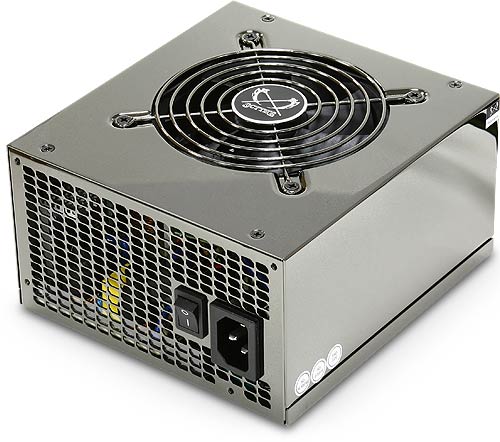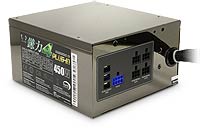Kamariki 4 750W Ultra-Quiet Modular Power Supply Discontinued | |
Kamariki 4 650W Ultra-Quiet Plug-in Power Supply Discontinued | |
Kamariki 4 550W Ultra-Quiet Plug-in Power Supply Discontinued | |
Kamariki 4 450W Ultra-Quiet Plug-in Power Supply Discontinued | |
| More variations available Show | |
Kamariki 4 Ultra-Quiet Plug-in Power Supplies
Scythe’s debut in the power supply market features a built-in fan controller and ultra quiet fan, plus a fully modular connectivity system.
Scythe’s Kamariki 4 power supplies feature a fully modular cable connectivity system called “Plug-in”. By having detachable power cables, you can remove the cables you don’t need and avoid cluttering up the inside of your case with unnecessary wiring. This makes working on your PC much easier, as well as improving airflow. The Kamariki power supplies are available in four different wattages from 450W to 750W. Each PSU uses the famous Scythe Kaze Jyu 100 mm fan to ensure efficient cooling.
It is also possible to connect up to three case fans to the Intelligent Fan Cable Connector which automatically adjusts the fan speed of those fans according to the loading of the power supply. The case fans can be connected directly or via the supplied modular fan cable. In order to satisfy customer demands as well as the green IT movement, the Scythe Kamariki 4 PSU series fully conform to the 80Plus standard at 20/50/100% system load.
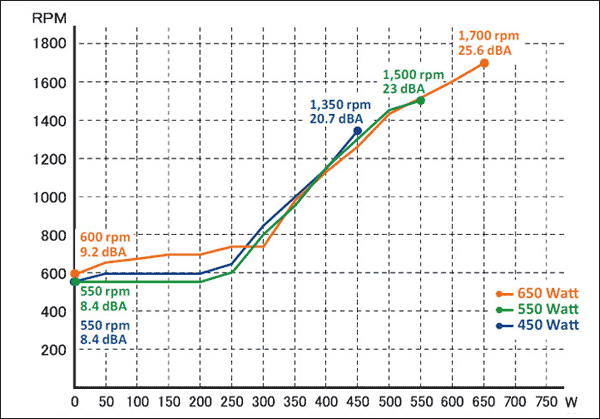
Image showing noise levels at a given load
Features
- Exceptionally quiet
- Modular design
- Specially designed fan grill
- Built in automatic fan controller based on PSU load
- Cooled using a Scythe Kaze Jyu 100 mm fan
| Specifications | 450W Modular | 550W Modular | 650W Modular | 750W Modular |
|---|---|---|---|---|
| Model Number | KMRK4-P-450A | KMRK4-P-550A | KMRK4-P-650A | KMRK4-P-750A |
| +3.3V max load | 25 A | 25 A | 25 A | 28 A |
| +5V max load | 25 A | 25 A | 25 A | 20 A |
| +12V1 max load | 18 A | 25 A | 25 A | 20 A |
| +12V2 max load | 18 A | 25 A | 25 A | 20 A |
| +12V3 max load | 20 A | |||
| +12V4 max load | 20 A | |||
| +12V Combined | 400W | 450W | 552W | 650 W |
| Combined maximum output +3.3V / +5V | 130 W | 150 W | 150 W | 180 W |
| -12V max load | 0.3 A | 0.3 A | 0.3 A | 0.8 A |
| +5VSB maximum standby current | 2.5 A | 2.5 A | 2.5 A | 3.0 A |
| Dimensions | 160L x 150W x 86H mm (including fan) | 160L x 150W x 86H mm (including fan) | 160L x 150W x 86H mm (including fan) | 160L x 150W x 86H mm (including fan) |
| Cable Length | 45 – 55 cm Mesh-Type cables | 45 – 55 cm Mesh-Type cables | 45 – 55 cm Mesh-Type cables | 45 – 55 cm Mesh-Type cables |
| Efficiency | 84% (80PLUS Certified) | 84% (80PLUS Certified) | 84% (80PLUS Certified) | 84% (80PLUS Certified) |
| Noise Level | 8.4 - 20.7 dBA | 8.4 - 23.0 dBA | 9.2 - 25.6 dBA | 9.2 – 25.6 dBA |
| Fan | Scythe Kaze Jyu 100 mm, 1350 RPM | Scythe Kaze Jyu 100 mm, 1500 RPM | Scythe Kaze Jyu 100 mm, 1700 RPM | Scythe Kaze Jyu 100 mm, 1750 RPM |
| Safety | CE, TUV, CB, FCC | CE, TUV, CB, FCC | CE, TUV, CB, FCC | CE, TUV, CB, FCC |
| Protection | Over Current, Over Voltage, Short Circuit | Over Current, Over Voltage, Short Circuit | Over Current, Over Voltage, Short Circuit | Over Current, Over Voltage, Short Circuit |
| Number of hard drive connectors | 6 | 6 | 6 | 8 |
| SATA connectors | 6 | 8 | 8 | 10 |
| Number of floppy drive connectors | 2 | 2 | 2 | 2 |
| Fan Connectors | 3 | 3 | 3 | 3 |
| ATX12V/ESP12V (4/8-pin) support | Yes | Yes | Yes | Yes |
| 20/24-pin ATX connector | Yes | Yes | Yes | Yes |
| PCI-E support | One 6/8-pin | Two 6/8-pin | Two 6/8-pin | Four 6/8-pin |
| ATX12V version | 2.3, EPS 12V | 2.3, EPS 12V | 2.3, EPS 12V | 2.3, EPS 12V |
| Warranty | 24 months | 24 months | 24 months | 24 months |
| Specifications | 450W Modular | 550W Modular | 650W Modular | 750W Modular |
|---|---|---|---|---|
| Model Number | KMRK4-P-450A | KMRK4-P-550A | KMRK4-P-650A | KMRK4-P-750A |
| +3.3V max load | 25 A | 28 A | ||
| +5V max load | 25 A | 20 A | ||
| +12V1 max load | 18 A | 25 A | 20 A | |
| +12V2 max load | 18 A | 25 A | 20 A | |
| +12V3 max load | 20 A | |||
| +12V4 max load | 20 A | |||
| +12V Combined | 400W | 450W | 552W | 650 W |
| Combined maximum output +3.3V / +5V | 130 W | 150 W | 180 W | |
| -12V max load | 0.3 A | 0.8 A | ||
| +5VSB maximum standby current | 2.5 A | 3.0 A | ||
| Dimensions | 160L x 150W x 86H mm (including fan) | |||
| Cable Length | 45 – 55 cm Mesh-Type cables | |||
| Efficiency | 84% (80PLUS Certified) | |||
| Noise Level | 8.4 - 20.7 dBA | 8.4 - 23.0 dBA | 9.2 - 25.6 dBA | 9.2 – 25.6 dBA |
| Fan | Scythe Kaze Jyu 100 mm, 1350 RPM | Scythe Kaze Jyu 100 mm, 1500 RPM | Scythe Kaze Jyu 100 mm, 1700 RPM | Scythe Kaze Jyu 100 mm, 1750 RPM |
| Safety | CE, TUV, CB, FCC | |||
| Protection | Over Current, Over Voltage, Short Circuit | |||
| Number of hard drive connectors | 6 | 8 | ||
| SATA connectors | 6 | 8 | 10 | |
| Number of floppy drive connectors | 2 | |||
| Fan Connectors | 3 | |||
| ATX12V/ESP12V (4/8-pin) support | Yes | |||
| 20/24-pin ATX connector | Yes | |||
| PCI-E support | One 6/8-pin | Two 6/8-pin | Four 6/8-pin | |
| ATX12V version | 2.3, EPS 12V | |||
| Warranty | 24 months | |||
Customer Reviews
We haven't received any reviews of this product yet.
We haven't received any reviews of this product yet.
Seriously hush-hust
Bought this to replace another ‘quiet psu’ - the silence is deafening! When I walk in and nothing else (than my 24/7 PC) is on I don’t hear it at ALL. Before it was drowned by the TV but now it is drowned by nothing. BUY THIS - it is absolutely amazing. (Oh, 3GHz AMD runs 150W, well inside this PSU’s range - which no doubt helps too.)
Ultra quiet, ultra pleased!
I had emailed Andy (QuietPC) for a recommendation for a quiet PSU to go in my new machine intended for use in my studio. This Kamariki was his suggestion and what a difference it made. I already had a pretty quiet PSU, but it was still the noisiest part of the system. This Kamariki is so quiet, it may as well not be there. Superb product and the modular cabling has considerably tidied up the inside of the case.
Only one problem… I’m now going to have to spend some more hard-earned on silencing the hard disks I couldn’t hear before I put this in ;-)
A beautiful piece of kit
I agree with John Niven - whisper quiet, excellent selection of modular cables (and very shiny!) All I can hear now is the occasional hard disk access and the AMD stock fan on my phenom II (which isn’t too bad).
FYI - from the packaging noise levels are 8.4 dBA up to c. 250W load then pretty much linear increase to 23 dBA at the full 550W.
Beautiful, well designed PSU
I purchased this for its noise-level, with its modular power-cabling as a secondary issue. When it arrived I found a third issue - it’s beautiful! In use it’s whisper quiet (the AMD-supplied CPU fan makes more noise), and I wouldn’t go back to a traditional PSU. The modular cabling is superb, and another reason I’d stick with this PSU. My case is opaque, but if any PSU made me buy a windowed-case it would be this one - it’s so shiny!
Wouldn't know it's there...
This is so quiet you don’t know it’s there, and the modular cabling means you can achieve Zen-master cable tidying inside. Very highly recommended.
Product Resources
FAQ
Do high wattage power supplies cost more to run?
No - the rated wattage of a power supply refers to the maximum amount of power it can deliver at full load, not how much power it uses. More powerful PSUs will consume around the same amount of power as lower powered power supplies in any given PC system, so your electricity bill will not be higher when using a more powerful power supply!
The best way to reduce your electricity bill when using your PC is to use a more efficient power supply or make your PC consume less power by removing components which are not needed, such as extra drives and expansion cards, or by choosing a cooler-running processor or graphics card.
My brand new power supply doesn’t work! Am I doing something wrong?
It’s possible that the power supply may be faulty, but here are some simple things to check. Firstly, a power supply will not work if you simply plug it in and flick the switch. The power supply will only turn on if you connect it to a working motherboard and associated items (processor, memory, video card, etc). It is actually the motherboard which tells the power supply when to switch on.
Secondly (if applicable), check the voltage is set correctly to 115/230 volts depending on what country you are in. Thirdly, if possible it would be good to try the power supply in another PC to see if it works, or try another power supply in your PC to see if that works. You can then tell whether it is the power supply which is faulty or the actual PC itself. If all else fails, please contact us for further support, and/or return details.
Why should I buy a whole new PSU when I could just replace the noisy fan in my existing one?
Virtually all the noise generated by a PC power supply originates from the cooling fan inside it, so simply replacing the fan with a quiet fan may seem an obvious way to go. However, if you are thinking about attempting this operation, please bear the following points in mind:
- Your existing power supply will be designed to run with a specific amount of airflow in order to adequately cool the components inside and reducing the airflow may lead to overheating and damage to the power supply and/or PC.
- All PC power supplies contain very high voltages and even with the power disconnected, the voltages stored in the capacitors can be easily enough to kill. It is not recommended to take the cover off any PC power supply for this reason unless you are absolutely confident of your own ability. Because of the grave dangers involved, all PC power supplies by law carry a warning label forbidding removal of the power supply case.
- There will be no standard PC fan connector inside the power supply to use to connect a replacement fan, and it would probably have to be soldered directly into the PCB inside the power supply, or have a specialist power connector attached. This can be a tricky operation to say the least.
Please consider the above points very carefully before proceeding with an operation to replace the fan in your existing power supply!
What is PFC (Power Factor Correction)?
If you are interested in being “green” and saving the planet, you might like to read a short explanation of how our power supplies can save energy using Active PFC (Power Factor Correction), not to be confused with Power Conversion Efficiency which is also very good in most of our PSUs. “Power Factor” is a measure of how efficiently electrical power is consumed. Ideally, Power Factor would be 1 (or 100%) and known as unity.
Unfortunately in the real world, Power Factor is reduced by highly inductive loads down to values of 0.7 (70%) or less. This induction is caused by equipment such as small electric motors, fans, fluorescent lighting ballasts and transformers such as those in PSUs. This is bad news for the electricity generating companies who can impose a surcharge on heavy users if they have a consistently low Power Factor, as more electricity has to be produced to make up the shortfall.
Power Factor Correction (PFC) is used in some equipment to minimise the inductive component of the electrical current. This helps to reduce the losses in the electrical supply to that equipment. Power Factor Correction capacitors are normally used to reduce induction in an electrical load, which minimises wasted energy and hence improves the efficiency of a company and reduces electricity costs.
It is not usually practical to reach unity, i.e. Power Factor 1, and it seems that most electricity supply companies accept consumers having a Power Factor as low as 0.94 (94%) without imposing a surcharge. Unfortunately most of the cheap (and not so cheerful) PSUs tend to have a Passive PF as low as 0.75 or 75% which in a large office can lead to a PF surcharge.
However, the good news is that most of Quiet PC’s PSUs implement a system known as Active PFC which involves some clever electronics. This means that their power factor (PF) can be as high as 0.94 or 94% (at full load), while harmful harmonic frequencies are reduced to well below legal requirements. So by using our products, you can be happy in the knowledge that you are doing your bit to save the planet!
How do I know what size of wattage power supply I need?
The best answer we can give to this question is to go ahead and take an intelligent “guesstimate”! There are no hard and fast rules about what size of power supply any given PC needs as a minimum. Our advice would be that if you are replacing an existing power supply, then consider a new one at least of the same wattage as the old one. In addition, if you wish to build in a “safety margin” to allow for reliable running and possible future upgrades, consider adding 100-200 watts to the rating of your existing unit.
If you are building a new PC, most customers now buy a power supply rated in the region of 500-800 watts depending primarily on the performance level of their graphics card(s) and number of drives to be installed. But in any event if you are unsure about which power supply would be best for your PC then please do contact us by phone or email and we will be happy to give you a specific recommendation based on your budget.
My new PSU came with a 24-pin connector but my motherboard needs 20 pins! Do I need an adaptor cable?
We receive many customer enquiries about this. In fact, most of the 24-pin compatible power supplies we sell come with special motherboard connectors which can be converted to 20-pins with no additional conversion cables. All you need to do is look carefully at the connector and you will see that the end four pins can be slid off, turning the connector into a 20-pin compatible one (see below) - easy when you know how!
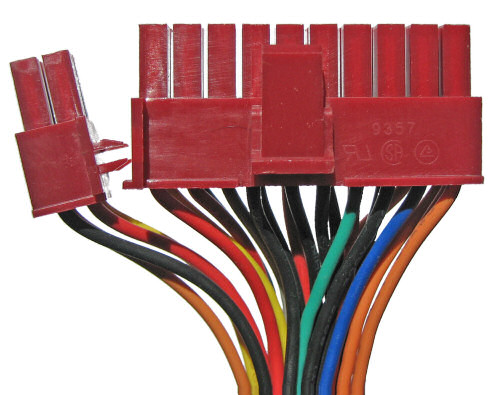
Image showing how to change a power supply’s 24-pin motherboard connector into a 20-pin connector by unclipping the end four-pin blockWhat do the PSU safety protection abbreviations mean?
There are many possible safety protections a PSU can have. Below is a list of what each abbreviation means. Please note, not all PSUs have all safety protections.
- OCP - Over-Current Protection
- OVP - Over Voltage Protection
- UVP - Under Voltage Protection
- SCP - Short Circuit Protection
- OPP - Over Power Protection
- OTP - Over Temperature Protection
- UL - Underwriters Laboratories, more information.
- TÜV - Technical Inspection Association, more information.
- CE - European Conformity, more information.
- FCC - Federal Communications Commission, more information.
- RoHS - Restriction of Hazardous Substances Directive, more information.
- WEE - Electronic waste, more information.
- 80 PLUS - Promotes energy efficiency for PC power supplies, more information.
- ErP - Energy Related Products, more information.
More information on certification marks can be found here.
Top Quiet Power Supplies

Streacom ST-ZF240 ZeroFlex 240W Passive PSU

Streacom ST-NANO160 160W nanoPSU and AC/DC adapter block

Seasonic PRIME Fanless 500W 80PLUS Platinum Modular Power Supply
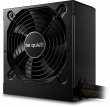
be quiet System Power 10 650W 80Plus Bronze PSU

Streacom ST-NANO120 120W nanoPSU and AC/DC adapter block
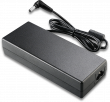
Akasa 120W Thin mini-ITX power adapter, AK-PD120-04M
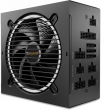
be quiet Pure Power 12 M 550W 80+ Gold Fully Modular ATX3.0 PSU
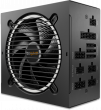
be quiet Pure Power 12 M 750W 80+ Gold Fully Modular ATX3.0 PSU
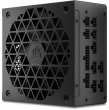
Corsair SF850L 850W SFX-L Semi-fanless ATX 3.0 PSU

be quiet Pure Power 11 400W Quiet PSU 80PLUS Gold

